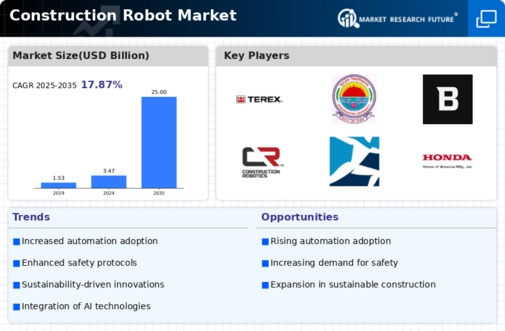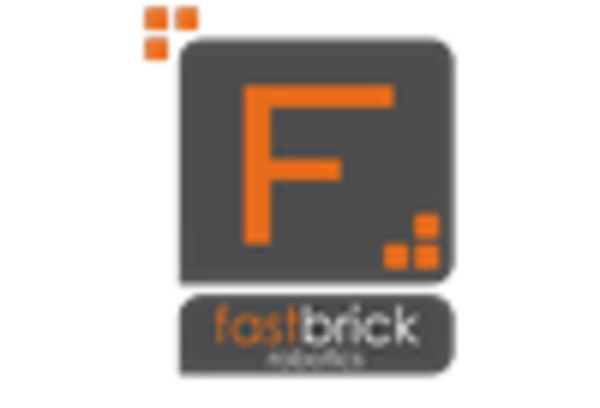Bricklaying
Demolition
Painting
Groundworks
Autonomous Mobile Robots
Exoskeletons
Drones
Robotic Arms
Residential Construction
Commercial Construction
Industrial Construction
North America
Europe
South America
Asia Pacific
Middle East and Africa
North America Outlook (USD Billion, 2019-2035)
North America Construction Robot Market by Application Type
Bricklaying
Demolition
Painting
Groundworks
North America Construction Robot Market by Type
Autonomous Mobile Robots
Exoskeletons
Drones
Robotic Arms
North America Construction Robot Market by End Use Type
Residential Construction
Commercial Construction
Industrial Construction
North America Construction Robot Market by Regional Type
US
Canada
US Outlook (USD Billion, 2019-2035)
US Construction Robot Market by Application Type
Bricklaying
Demolition
Painting
Groundworks
US Construction Robot Market by Type
Autonomous Mobile Robots
Exoskeletons
Drones
Robotic Arms
US Construction Robot Market by End Use Type
Residential Construction
Commercial Construction
Industrial Construction
CANADA Outlook (USD Billion, 2019-2035)
CANADA Construction Robot Market by Application Type
Bricklaying
Demolition
Painting
Groundworks
CANADA Construction Robot Market by Type
Autonomous Mobile Robots
Exoskeletons
Drones
Robotic Arms
CANADA Construction Robot Market by End Use Type
Residential Construction
Commercial Construction
Industrial Construction
Europe Outlook (USD Billion, 2019-2035)
Europe Construction Robot Market by Application Type
Bricklaying
Demolition
Painting
Groundworks
Europe Construction Robot Market by Type
Autonomous Mobile Robots
Exoskeletons
Drones
Robotic Arms
Europe Construction Robot Market by End Use Type
Residential Construction
Commercial Construction
Industrial Construction
Europe Construction Robot Market by Regional Type
Germany
UK
France
Russia
Italy
Spain
Rest of Europe
GERMANY Outlook (USD Billion, 2019-2035)
GERMANY Construction Robot Market by Application Type
Bricklaying
Demolition
Painting
Groundworks
GERMANY Construction Robot Market by Type
Autonomous Mobile Robots
Exoskeletons
Drones
Robotic Arms
GERMANY Construction Robot Market by End Use Type
Residential Construction
Commercial Construction
Industrial Construction
UK Outlook (USD Billion, 2019-2035)
UK Construction Robot Market by Application Type
Bricklaying
Demolition
Painting
Groundworks
UK Construction Robot Market by Type
Autonomous Mobile Robots
Exoskeletons
Drones
Robotic Arms
UK Construction Robot Market by End Use Type
Residential Construction
Commercial Construction
Industrial Construction
FRANCE Outlook (USD Billion, 2019-2035)
FRANCE Construction Robot Market by Application Type
Bricklaying
Demolition
Painting
Groundworks
FRANCE Construction Robot Market by Type
Autonomous Mobile Robots
Exoskeletons
Drones
Robotic Arms
FRANCE Construction Robot Market by End Use Type
Residential Construction
Commercial Construction
Industrial Construction
RUSSIA Outlook (USD Billion, 2019-2035)
RUSSIA Construction Robot Market by Application Type
Bricklaying
Demolition
Painting
Groundworks
RUSSIA Construction Robot Market by Type
Autonomous Mobile Robots
Exoskeletons
Drones
Robotic Arms
RUSSIA Construction Robot Market by End Use Type
Residential Construction
Commercial Construction
Industrial Construction
ITALY Outlook (USD Billion, 2019-2035)
ITALY Construction Robot Market by Application Type
Bricklaying
Demolition
Painting
Groundworks
ITALY Construction Robot Market by Type
Autonomous Mobile Robots
Exoskeletons
Drones
Robotic Arms
ITALY Construction Robot Market by End Use Type
Residential Construction
Commercial Construction
Industrial Construction
SPAIN Outlook (USD Billion, 2019-2035)
SPAIN Construction Robot Market by Application Type
Bricklaying
Demolition
Painting
Groundworks
SPAIN Construction Robot Market by Type
Autonomous Mobile Robots
Exoskeletons
Drones
Robotic Arms
SPAIN Construction Robot Market by End Use Type
Residential Construction
Commercial Construction
Industrial Construction
REST OF EUROPE Outlook (USD Billion, 2019-2035)
REST OF EUROPE Construction Robot Market by Application Type
Bricklaying
Demolition
Painting
Groundworks
REST OF EUROPE Construction Robot Market by Type
Autonomous Mobile Robots
Exoskeletons
Drones
Robotic Arms
REST OF EUROPE Construction Robot Market by End Use Type
Residential Construction
Commercial Construction
Industrial Construction
APAC Outlook (USD Billion, 2019-2035)
APAC Construction Robot Market by Application Type
Bricklaying
Demolition
Painting
Groundworks
APAC Construction Robot Market by Type
Autonomous Mobile Robots
Exoskeletons
Drones
Robotic Arms
APAC Construction Robot Market by End Use Type
Residential Construction
Commercial Construction
Industrial Construction
APAC Construction Robot Market by Regional Type
China
India
Japan
South Korea
Malaysia
Thailand
Indonesia
Rest of APAC
CHINA Outlook (USD Billion, 2019-2035)
CHINA Construction Robot Market by Application Type
Bricklaying
Demolition
Painting
Groundworks
CHINA Construction Robot Market by Type
Autonomous Mobile Robots
Exoskeletons
Drones
Robotic Arms
CHINA Construction Robot Market by End Use Type
Residential Construction
Commercial Construction
Industrial Construction
INDIA Outlook (USD Billion, 2019-2035)
INDIA Construction Robot Market by Application Type
Bricklaying
Demolition
Painting
Groundworks
INDIA Construction Robot Market by Type
Autonomous Mobile Robots
Exoskeletons
Drones
Robotic Arms
INDIA Construction Robot Market by End Use Type
Residential Construction
Commercial Construction
Industrial Construction
JAPAN Outlook (USD Billion, 2019-2035)
JAPAN Construction Robot Market by Application Type
Bricklaying
Demolition
Painting
Groundworks
JAPAN Construction Robot Market by Type
Autonomous Mobile Robots
Exoskeletons
Drones
Robotic Arms
JAPAN Construction Robot Market by End Use Type
Residential Construction
Commercial Construction
Industrial Construction
SOUTH KOREA Outlook (USD Billion, 2019-2035)
SOUTH KOREA Construction Robot Market by Application Type
Bricklaying
Demolition
Painting
Groundworks
SOUTH KOREA Construction Robot Market by Type
Autonomous Mobile Robots
Exoskeletons
Drones
Robotic Arms
SOUTH KOREA Construction Robot Market by End Use Type
Residential Construction
Commercial Construction
Industrial Construction
MALAYSIA Outlook (USD Billion, 2019-2035)
MALAYSIA Construction Robot Market by Application Type
Bricklaying
Demolition
Painting
Groundworks
MALAYSIA Construction Robot Market by Type
Autonomous Mobile Robots
Exoskeletons
Drones
Robotic Arms
MALAYSIA Construction Robot Market by End Use Type
Residential Construction
Commercial Construction
Industrial Construction
THAILAND Outlook (USD Billion, 2019-2035)
THAILAND Construction Robot Market by Application Type
Bricklaying
Demolition
Painting
Groundworks
THAILAND Construction Robot Market by Type
Autonomous Mobile Robots
Exoskeletons
Drones
Robotic Arms
THAILAND Construction Robot Market by End Use Type
Residential Construction
Commercial Construction
Industrial Construction
INDONESIA Outlook (USD Billion, 2019-2035)
INDONESIA Construction Robot Market by Application Type
Bricklaying
Demolition
Painting
Groundworks
INDONESIA Construction Robot Market by Type
Autonomous Mobile Robots
Exoskeletons
Drones
Robotic Arms
INDONESIA Construction Robot Market by End Use Type
Residential Construction
Commercial Construction
Industrial Construction
REST OF APAC Outlook (USD Billion, 2019-2035)
REST OF APAC Construction Robot Market by Application Type
Bricklaying
Demolition
Painting
Groundworks
REST OF APAC Construction Robot Market by Type
Autonomous Mobile Robots
Exoskeletons
Drones
Robotic Arms
REST OF APAC Construction Robot Market by End Use Type
Residential Construction
Commercial Construction
Industrial Construction
South America Outlook (USD Billion, 2019-2035)
South America Construction Robot Market by Application Type
Bricklaying
Demolition
Painting
Groundworks
South America Construction Robot Market by Type
Autonomous Mobile Robots
Exoskeletons
Drones
Robotic Arms
South America Construction Robot Market by End Use Type
Residential Construction
Commercial Construction
Industrial Construction
South America Construction Robot Market by Regional Type
Brazil
Mexico
Argentina
Rest of South America
BRAZIL Outlook (USD Billion, 2019-2035)
BRAZIL Construction Robot Market by Application Type
Bricklaying
Demolition
Painting
Groundworks
BRAZIL Construction Robot Market by Type
Autonomous Mobile Robots
Exoskeletons
Drones
Robotic Arms
BRAZIL Construction Robot Market by End Use Type
Residential Construction
Commercial Construction
Industrial Construction
MEXICO Outlook (USD Billion, 2019-2035)
MEXICO Construction Robot Market by Application Type
Bricklaying
Demolition
Painting
Groundworks
MEXICO Construction Robot Market by Type
Autonomous Mobile Robots
Exoskeletons
Drones
Robotic Arms
MEXICO Construction Robot Market by End Use Type
Residential Construction
Commercial Construction
Industrial Construction
ARGENTINA Outlook (USD Billion, 2019-2035)
ARGENTINA Construction Robot Market by Application Type
Bricklaying
Demolition
Painting
Groundworks
ARGENTINA Construction Robot Market by Type
Autonomous Mobile Robots
Exoskeletons
Drones
Robotic Arms
ARGENTINA Construction Robot Market by End Use Type
Residential Construction
Commercial Construction
Industrial Construction
REST OF SOUTH AMERICA Outlook (USD Billion, 2019-2035)
REST OF SOUTH AMERICA Construction Robot Market by Application Type
Bricklaying
Demolition
Painting
Groundworks
REST OF SOUTH AMERICA Construction Robot Market by Type
Autonomous Mobile Robots
Exoskeletons
Drones
Robotic Arms
REST OF SOUTH AMERICA Construction Robot Market by End Use Type
Residential Construction
Commercial Construction
Industrial Construction
MEA Outlook (USD Billion, 2019-2035)
MEA Construction Robot Market by Application Type
Bricklaying
Demolition
Painting
Groundworks
MEA Construction Robot Market by Type
Autonomous Mobile Robots
Exoskeletons
Drones
Robotic Arms
MEA Construction Robot Market by End Use Type
Residential Construction
Commercial Construction
Industrial Construction
MEA Construction Robot Market by Regional Type
GCC Countries
South Africa
Rest of MEA
GCC COUNTRIES Outlook (USD Billion, 2019-2035)
GCC COUNTRIES Construction Robot Market by Application Type
Bricklaying
Demolition
Painting
Groundworks
GCC COUNTRIES Construction Robot Market by Type
Autonomous Mobile Robots
Exoskeletons
Drones
Robotic Arms
GCC COUNTRIES Construction Robot Market by End Use Type
Residential Construction
Commercial Construction
Industrial Construction
SOUTH AFRICA Outlook (USD Billion, 2019-2035)
SOUTH AFRICA Construction Robot Market by Application Type
Bricklaying
Demolition
Painting
Groundworks
SOUTH AFRICA Construction Robot Market by Type
Autonomous Mobile Robots
Exoskeletons
Drones
Robotic Arms
SOUTH AFRICA Construction Robot Market by End Use Type
Residential Construction
Commercial Construction
Industrial Construction
REST OF MEA Outlook (USD Billion, 2019-2035)
REST OF MEA Construction Robot Market by Application Type
Bricklaying
Demolition
Painting
Groundworks
REST OF MEA Construction Robot Market by Type
Autonomous Mobile Robots
Exoskeletons
Drones
Robotic Arms
REST OF MEA Construction Robot Market by End Use Type
Residential Construction
Commercial Construction
Industrial Construction

















Leave a Comment